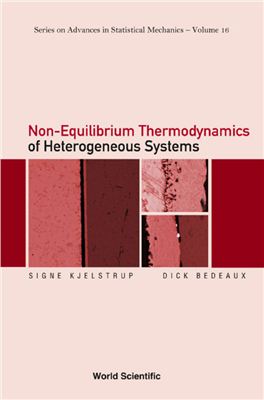World Scientific Publishing Company, 2008. 452 p.
ISBN-13:978-981-277-913-7, ISBN-10 981-277-913-2
The purpose of this book is to encourage the use of non-equilibrium thermodynamics to describe transport in complex, heterogeneous media. With large coupling effects between the transport of heat, mass, charge and chemical reactions at surfaces, it is important to know how one should properly integrate across systems where different phases are in contact. No other book gives a prescription of how to set up flux equations for transports across heterogeneous systems.
The authors apply the thermodynamic description in terms of excess densities, developed by Gibbs for equilibrium, to non-equilibrium systems. The treatment is restricted to transport into and through the surface. Using local equilibrium together with the balance equations for the surface, expressions for the excess entropy production of the surface and of the contact line are derived. Many examples are given to illustrate how the theory can be applied to coupled transport of mass, heat, charge and chemical reactions; in phase transitions, at electrode surfaces and in fuel cells. Molecular simulations and analytical studies are used to add insight.
Contents: General Theory: The Entropy Production for a Homogeneous Phase; The Excess Entropy Production for the Surface; Flux Equations and Onsager Relations; Transport of Heat and Mass; Transport of Mass and Charge; Applications: Evaporation and Condensation; A Nonisothermal Concentration Cell; Adiabatic Electrode Reactions; The Formation Cell; Modeling the Polymer Electrolyte Fuel Cell; The Impedance of an Electrode Surface; The Non-Equilibrium Two-Phase van der Waals Model; and other chapters.
The purpose of this book is to encourage the use of non-equilibrium thermodynamics to describe transport in complex, heterogeneous media. With large coupling effects between the transport of heat, mass, charge and chemical reactions at surfaces, it is important to know how one should properly integrate across systems where different phases are in contact. No other book gives a prescription of how to set up flux equations for transports across heterogeneous systems.
The authors apply the thermodynamic description in terms of excess densities, developed by Gibbs for equilibrium, to non-equilibrium systems. The treatment is restricted to transport into and through the surface. Using local equilibrium together with the balance equations for the surface, expressions for the excess entropy production of the surface and of the contact line are derived. Many examples are given to illustrate how the theory can be applied to coupled transport of mass, heat, charge and chemical reactions; in phase transitions, at electrode surfaces and in fuel cells. Molecular simulations and analytical studies are used to add insight.
Contents: General Theory: The Entropy Production for a Homogeneous Phase; The Excess Entropy Production for the Surface; Flux Equations and Onsager Relations; Transport of Heat and Mass; Transport of Mass and Charge; Applications: Evaporation and Condensation; A Nonisothermal Concentration Cell; Adiabatic Electrode Reactions; The Formation Cell; Modeling the Polymer Electrolyte Fuel Cell; The Impedance of an Electrode Surface; The Non-Equilibrium Two-Phase van der Waals Model; and other chapters.

